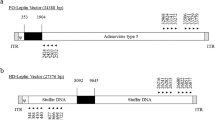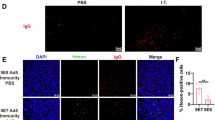Abstract
Adenovirus type 5 (Ad5) specifically binds coagulation factor X (FX), and FX is normally essential for intravenously injected Ad5 vectors to transduce the liver. We demonstrate that the ability of FX to enhance liver transduction by Ad5 vectors is due to an unexpected ability of FX to protect Ad5 from attack by the classical complement pathway. In vitro, naive mouse serum neutralized Ad5 when FX was blocked from binding Ad5. This neutralization was mediated by natural IgM and the classical complement pathway. In vivo, FX was essential for Ad5 vectors to transduce the livers of wild-type mice, but FX was not required for liver transduction in mice that lack antibodies, C1q or C4. We conclude that Ad5 recruits FX as a defense against complement and that the sensitivity of Ad5 to inactivation by complement must be taken into account when designing vectors for systemic gene therapy.
This is a preview of subscription content, access via your institution
Access options
Subscribe to this journal
Receive 12 print issues and online access
$259.00 per year
only $21.58 per issue
Buy this article
- Purchase on SpringerLink
- Instant access to full article PDF
Prices may be subject to local taxes which are calculated during checkout






Similar content being viewed by others
References
Cichon, G. et al. Complement activation by recombinant adenoviruses. Gene Ther. 8, 1794–1800 (2001).
Jiang, H., Wang, Z., Serra, D., Frank, M.M. & Amalfitano, A. Recombinant adenovirus vectors activate the alternative complement pathway, leading to the binding of human complement protein C3 independent of anti-Ad antibodies. Mol. Ther. 10, 1140–1142 (2004).
Shayakhmetov, D.M., Gaggar, A., Ni, S., Li, Z.Y. & Lieber, A. Adenovirus binding to blood factors results in liver cell infection and hepatotoxicity. J. Virol. 79, 7478–7491 (2005).
Perreau, M., Guerin, M.C., Drouet, C. & Kremer, E.J. Interactions between human plasma components and a xenogenic adenovirus vector: reduced immunogenicity during gene transfer. Mol. Ther. 15, 1998–2007 (2007).
Xu, Z., Tian, J., Smith, J.S. & Byrnes, A.P. Clearance of adenovirus by Kupffer cells is mediated by scavenger receptors, natural antibodies and complement. J. Virol. 82, 11705–11713 (2008).
Carlisle, R.C. et al. Human erythrocytes bind and inactivate type 5 adenovirus by presenting Coxsackie virus-adenovirus receptor and complement receptor 1. Blood 113, 1909–1918 (2009).
Tian, J. et al. Adenovirus activates complement by distinctly different mechanisms in vitro and in vivo: indirect complement activation by virions in vivo. J. Virol. 83, 5648–5658 (2009).
Ochsenbein, A.F. et al. Control of early viral and bacterial distribution and disease by natural antibodies. Science 286, 2156–2159 (1999).
Notkins, A.L. Polyreactivity of antibody molecules. Trends Immunol. 25, 174–179 (2004).
Racine, R. & Winslow, G.M. IgM in microbial infections: taken for granted? Immunol. Lett. 125, 79–85 (2009).
Rambach, G., Wurzner, R. & Speth, C. Complement: an efficient sword of innate immunity. Contrib. Microbiol. 15, 78–100 (2008).
He, J.Q. et al. CRIg mediates early Kupffer cell responses to adenovirus. J. Leukoc. Biol. 93, 301–306 (2013).
Kalyuzhniy, O. et al. Adenovirus serotype 5 hexon is critical for virus infection of hepatocytes in vivo. Proc. Natl. Acad. Sci. USA 105, 5483–5488 (2008).
Waddington, S.N. et al. Adenovirus serotype 5 hexon mediates liver gene transfer. Cell 132, 397–409 (2008).
Doronin, K. et al. Coagulation factor X activates innate immunity to human species C adenovirus. Science 338, 795–798 (2012).
Parker, A.L. et al. Multiple Vitamin K-dependent coagulation zymogens promote adenovirus-mediated gene delivery to hepatocytes in vitro and in vivo. Blood 108, 2554–2561 (2006).
Vigant, F. et al. Substitution of hexon hypervariable region 5 of adenovirus serotype 5 abrogates blood factor binding and limits gene transfer to liver. Mol. Ther. 16, 1474–1480 (2008).
Alba, R. et al. Identification of coagulation factor (F)X binding sites on the adenovirus serotype 5 hexon: effect of mutagenesis on FX interactions and gene transfer. Blood 114, 965–971 (2009).
Jonsson, M.I. et al. Coagulation factors IX and X enhance binding and infection of adenovirus types 5 and 31 in human epithelial cells. J. Virol. 83, 3816–3825 (2009).
Bradshaw, A.C. et al. Requirements for receptor engagement during infection by adenovirus complexed with blood coagulation factor X. PLoS Pathog. 6, e1001142 (2010).
Duffy, M.R., Bradshaw, A.C., Parker, A.L., McVey, J.H. & Baker, A.H. A cluster of basic amino acids in the factor X serine protease mediate surface attachment of adenovirus:FX complexes. J. Virol. 85, 10914–10919 (2011).
Coughlan, L. et al. Tropism-modification strategies for targeted gene delivery using adenoviral vectors. Viruses 2, 2290–2355 (2010).
Mombaerts, P. et al. Rag1-deficient mice have no mature B and T lymphocytes. Cell 68, 869–877 (1992).
Atoda, H., Ishikawa, M., Mizuno, H. & Morita, T. Coagulation factor X-binding protein from Deinagkistrodon acutus venom is a Gla domain-binding protein. Biochemistry 37, 17361–17370 (1998).
Campos, S.K. & Barry, M.A. Rapid construction of capsid-modified adenoviral vectors through bacteriophage lambda Red recombination. Hum. Gene Ther. 15, 1125–1130 (2004).
Smith, T.A. et al. Adenovirus serotype 5 fiber shaft influences in vivo gene transfer in mice. Hum. Gene Ther. 14, 777–787 (2003).
Klein-Schneegans, A.S., Kuntz, L., Trembleau, S., Fonteneau, P. & Loor, F. Serum concentrations of IgM, IgG1, IgG2b, IgG3 and IgA in C57BL/6 mice and their congenics at the nu (nude) locus. Thymus 16, 45–54 (1990).
Chen, J. et al. Immunoglobulin gene rearrangement in B cell deficient mice generated by targeted deletion of the JH locus. Int. Immunol. 5, 647–656 (1993).
Hannum, L.G., Haberman, A.M., Anderson, S.M. & Shlomchik, M.J. Germinal center initiation, variable gene region hypermutation, and mutant B cell selection without detectable immune complexes on follicular dendritic cells. J. Exp. Med. 192, 931–942 (2000).
Khare, R., Reddy, V.S., Nemerow, G.R. & Barry, M.A. Identification of adenovirus serotype 5 hexon regions that interact with scavenger receptors. J. Virol. 86, 2293–2301 (2012).
Alba, R. et al. Biodistribution and retargeting of FX-binding ablated adenovirus serotype 5 vectors. Blood 116, 2656–2664 (2010).
Amara, U. et al. Molecular intercommunication between the complement and coagulation systems. J. Immunol. 185, 5628–5636 (2010).
Beebe, D.P. & Cooper, N.R. Neutralization of vesicular stomatitis virus (VSV) by human complement requires a natural IgM antibody present in human serum. J. Immunol. 126, 1562–1568 (1981).
Rother, R.P. et al. A novel mechanism of retrovirus inactivation in human serum mediated by anti-alpha-galactosyl natural antibody. J. Exp. Med. 182, 1345–1355 (1995).
DePolo, N.J. et al. VSV-G pseudotyped lentiviral vector particles produced in human cells are inactivated by human serum. Mol. Ther. 2, 218–222 (2000).
Sokoloff, A.V. et al. Specific recognition of protein carboxy-terminal sequences by natural IgM antibodies in normal serum. Mol. Ther. 3, 821–830 (2001).
Wakimoto, H. et al. The complement response against an oncolytic virus is species-specific in its activation pathways. Mol. Ther. 5, 275–282 (2002).
Hoare, J., Waddington, S., Thomas, H.C., Coutelle, C. & McGarvey, M.J. Complement inhibition rescued mice allowing observation of transgene expression following intraportal delivery of baculovirus in mice. J. Gene Med. 7, 325–333 (2005).
Jayasekera, J.P., Moseman, E.A. & Carroll, M.C. Natural antibody and complement mediate neutralization of influenza virus in the absence of prior immunity. J. Virol. 81, 3487–3494 (2007).
Moulton, E.A., Atkinson, J.P. & Buller, R.M. Surviving mousepox infection requires the complement system. PLoS Pathog. 4, e1000249 (2008).
Lambris, J.D., Ricklin, D. & Geisbrecht, B.V. Complement evasion by human pathogens. Nat. Rev. Microbiol. 6, 132–142 (2008).
Stoermer, K.A. & Morrison, T.E. Complement and viral pathogenesis. Virology 411, 362–373 (2011).
Carlsson, F., Sandin, C. & Lindahl, G. Human fibrinogen bound to Streptococcus pyogenes M protein inhibits complement deposition via the classical pathway. Mol. Microbiol. 56, 28–39 (2005).
Prill, J.M. et al. Modifications of adenovirus hexon allow for either hepatocyte detargeting or targeting with potential evasion from Kupffer cells. Mol. Ther. 19, 83–92 (2011).
Shayakhmetov, D.M., Li, Z.Y., Ni, S. & Lieber, A. Analysis of adenovirus sequestration in the liver, transduction of hepatic cells, and innate toxicity after injection of fiber-modified vectors. J. Virol. 78, 5368–5381 (2004).
Xu, Z.L. et al. Strength evaluation of transcriptional regulatory elements for transgene expression by adenovirus vector. J. Control. Release 81, 155–163 (2002).
Smith, J.S., Tian, J., Muller, J. & Byrnes, A.P. Unexpected pulmonary uptake of adenovirus vectors in animals with chronic liver disease. Gene Ther. 11, 431–438 (2004).
Manickan, E. et al. Rapid Kupffer cell death after intravenous injection of adenovirus vectors. Mol. Ther. 13, 108–117 (2006).
Förster, I. & Rajewsky, K. Expansion and functional activity of Ly-1+ B cells upon transfer of peritoneal cells into allotype-congenic, newborn mice. Eur. J. Immunol. 17, 521–528 (1987).
Lachmann, P.J. Preparing serum for functional complement assays. J. Immunol. Methods 352, 195–197 (2010).
Kettner, C. & Shaw, E. D-Phe-Pro-ArgCH2C1-A selective affinity label for thrombin. Thromb. Res. 14, 969–973 (1979).
McCarthy, D.A. & Macey, M.G. Novel anticoagulants for flow cytometric analysis of live leucocytes in whole blood. Cytometry 23, 196–204 (1996).
Kettner, C. & Shaw, E. The selective affinity labeling of factor Xa by peptides of arginine chloromethyl ketone. Thromb. Res. 22, 645–652 (1981).
Wiethoff, C.M., Wodrich, H., Gerace, L. & Nemerow, G.R. Adenovirus protein VI mediates membrane disruption following capsid disassembly. J. Virol. 79, 1992–2000 (2005).
Acknowledgements
Funding was provided by the US Food and Drug Administration (FDA), including the FDA's Critical Path program. This project was supported in part by fellowships administered by the Oak Ridge Institute for Science and Education. We thank M. Barry (Mayo Clinic) for providing vectors, H. Mizuguchi (Osaka University) for providing plasmid pAdHM4-CMVL1 and M. Diamond (Washington University) for providing C1qa−/− mice. We thank M. Shlomchik (Yale University), S. Epstein (FDA) and J. Misplon (FDA) for providing JHD and mIg Tg mice. We thank the Center for Biologics Evaluation and Research animal facility staff for outstanding support. We thank S. Epstein, C. Kimchi-Sarfaty, G. Price and C. Wiethoff for helpful discussions or comments on the manuscript.
Author information
Authors and Affiliations
Contributions
Z.X. discovered that coagulation factors are not required for liver transduction. A.P.B., Z.X., Q.Q., J.T. and J.S.S. designed experiments. Z.X. performed all in vivo experiments, collected serum and plasma, purified IgM, constructed AdHVR7, grew vectors, and performed quantitative PCR, western blotting and Octet RED assays. Q.Q. performed quantitative PCR and conducted in vitro transduction and neutralization studies. J.T. conducted complement activity assays and grew vectors. J.S.S. conducted cell-binding assays. G.M.C. conducted transduction assays. T.M. purified X-bp. A.P.B. bred mice. A.P.B. wrote the majority of the manuscript, and all authors participated in the preparation of the manuscript.
Corresponding author
Ethics declarations
Competing interests
The authors declare no competing financial interests.
Supplementary information
Supplementary Text and Figures
Supplementary Figures 1–8 and Supplementary Tables 1 and 2 (PDF 688 kb)
Rights and permissions
About this article
Cite this article
Xu, Z., Qiu, Q., Tian, J. et al. Coagulation factor X shields adenovirus type 5 from attack by natural antibodies and complement. Nat Med 19, 452–457 (2013). https://doi.org/10.1038/nm.3107
Received:
Accepted:
Published:
Issue date:
DOI: https://doi.org/10.1038/nm.3107
This article is cited by
-
Effects of pre-existing anti-adenovirus antibodies on transgene expression levels and therapeutic efficacies of arming oncolytic adenovirus
Scientific Reports (2022)
-
Enhancing the antitumor activity of an engineered TRAIL-coated oncolytic adenovirus for treating acute myeloid leukemia
Signal Transduction and Targeted Therapy (2020)
-
Microbubble-mediated delivery of human adenoviruses does not elicit innate and adaptive immunity response in an immunocompetent mouse model of prostate cancer
Journal of Translational Medicine (2019)
-
Adenoviral vector with shield and adapter increases tumor specificity and escapes liver and immune control
Nature Communications (2018)
-
Barriers to systemic application of virus-based vectors in gene therapy: lessons from adenovirus type 5
Virus Genes (2017)



